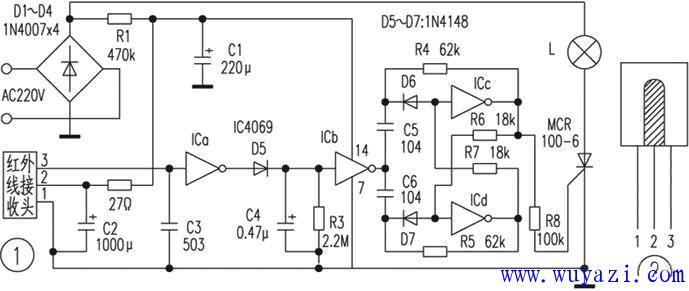Nowadays, it's common to have multiple infrared remote controls in homes, such as for TVs, VCDs, and VCRs. This circuit was designed with those devices in mind, allowing you to repurpose your remote control to send infrared signals and control lighting fixtures from a distance of over 8 meters. The circuit operates based on the principle shown in Figure 1. It mainly consists of an infrared receiving head and IC4069. When the infrared receiver is idle, it outputs a high voltage level. However, when it detects an infrared pulse signal from the remote control, the first pin of the receiver goes low (a pulse signal). This signal is then shaped, amplified, and inverted by ICa, resulting in a negative pulse. This pulse is detected by D5, C4, and R3, and sent to ICb. Once the threshold voltage of the inverter is reached, ICb outputs a low level. As C4 discharges through R3, the input voltage to ICb drops below the threshold, causing ICb to return to a high output. Each time the infrared transmitter is pressed, a negative pulse is generated at the output of IC6, which triggers a bistable circuit made up of ICc and ICd. This causes the bistable circuit to toggle between high and low output levels. The signal is then passed through R8 to control the conduction or cutoff of a unidirectional thyristor, thereby controlling the lighting fixture. The 220V AC power supply is rectified and stepped down using D1–D4, R1, and C1 to provide a stable +5V DC power supply for the circuit. For testing and adjustment, as long as the components are correctly installed, you can measure the voltage at the TC4069 pins, which should be around +5V. If the voltage is too low, adjust the resistance of R1 accordingly. The power consumption of this circuit is very low, typically less than 0.5W. Note: The board may carry high voltage, so take precautions during testing to avoid electric shock. Component selection is crucial. The infrared receiver has a high internal DC resistance and requires a +5V operating voltage (as shown in Figure 2). The unidirectional thyristor (SCR) should be chosen with a power rating comparable to the selected incandescent lamp to prevent overcurrent damage. Fiber Optic Distribution Box,Fiber Optic Breakout Box,Fibre Optic Breakout Box,Fibre Break Out Box Cixi Dani Plastic Products Co.,Ltd , https://www.danifiberoptic.com
August 09, 2025